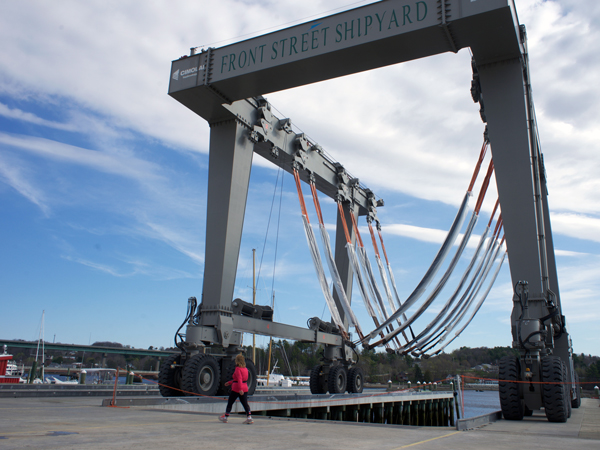From Sardines to Yachts, Belfast Transforms Its Waterfront
City, Front Street Shipyard collaborated to create a thriving working waterfront with public access.
By Tom Groening
It may have been inevitable. A part of Belfast’s waterfront characterized by graffiti-covered, decrepit industrial buildings wouldn’t remain so for long, given the safe bet that is investing in Maine harbor-front property. But the story of how Front Street Shipyard became established on that same property—now characterized by multi-million dollar yachts parked in and outside large green, steel-sided buildings—might seem like an overnight success story.
In fact, it’s a story that owes its happy ending to two groups of people who saw opportunity, and who were willing to work to find a way for each to win. Cliché though it might sound, the Front Street Shipyard and Belfast’s city government truly achieved a win-win. It may not have come to fruition without a bit of legal innovation with a name only a lawyer could love: contract rezoning.
THE SARDINE BEAST
The story begins with the demise of the sardine industry. In 2001, the Stinson Seafood plant on the city’s northeasterly waterfront was for sale. Wayne Marshall, the city’s planner, remembers Stinson asking $1.3 million for the property.
“It was pretty much an unusual beast,” this 1,000-feet of shorefront that was dormant industrial, yet close to the heart of downtown. It was flat, a plus for redevelopment, yet narrow, hemmed in by Front Street. “A real constraint on the property was that all of it was in the flood plain,” Marshall explained, and any development would need Department of Environmental Protection approval.
As the economy strengthened in the first decade of the century, the property drew interest from developers. Rather than allow a buyer to impose a vision, the city wanted a say in how this key property would develop.
“We established a contract zone goal statement,” Marshall remembers. “We would negotiate what the terms were.” Contract zoning allows municipalities to consider a range of development proposals, and to stipulate their own standards, and if both sides agree on a set of terms, a unique zone is created for an individual property. This provision is typically applied to larger properties.
In 2004, Tom Roberts, a would-be developer from New Jersey joined by four partners, applied to the city to redevelop the sardine plant as 22 residential condominiums, 14,000-square-feet of retail space and offices, a restaurant, and a 62-slip marina offering boat repair and storage.
He agreed to begin negotiating with the city on a contract rezoning deal—the first time the city employed this mechanism.
Roberts unveiled a design for the new building that mimicked the opera house in Sydney, Australia, resembling two giant sails. It received tepid reviews from residents and city officials. But the city’s harbor committee, planning board, and city council worked with the developer; Marshall remembers more than 25 meetings with Roberts, who landed financing for his proposal in 2005.
One key provision the city wanted in any deal with Roberts was his approval of a long-planned public walkway along the harbor, through the project site. The walkway idea originated in the late 1990s, Marshall said, with a renewed effort to establish it when the Armistice Bridge—the former U.S. Route 1 bridge, now known locally as the footbridge—was rebuilt in 2003.
In its negotiations with Roberts, the city also worked to establish protections for a small lobster fleet and to maintain public access from both the harbor and land. The contract between the city and Roberts was inked, but despite the deal, Roberts and his partners sought to sell the property and the project, perhaps because of a souring real estate market. By June 2008, Roberts and his group were ready to bail. Investors dipped in their toes, but none committed.
By late 2009 and into early 2010, Marshall said, “The property was becoming increasingly derelict. You could see water through the building from the street side. The owner was doing nothing. It was a safety hazard.”
The fate of the property, and the city’s vision for a public waterfront walkway, hung in the balance. If the building remained decrepit for another five years, city councilors could be blamed for driving too hard a bargain.
UNDER PRESSURE
In late 2010, the city learned of an inquiry about the property from four men: Taylor Allen, owner and operator of Rockport Marine; JB Turner, former president of Lyman-Morse in Thomaston; Steve White, owner and operator of Brooklin Boat Yard; and Ken Priest of Kenway Composites. The group planned not a boatyard, but a shipyard, capable of handling large yachts and commercial vessels at the Belfast site.
The city then took a bold step, filing a notice of violation in court, declaring the building dangerous. Though the safety concerns were real, the city’s action had the effect of pressuring the Roberts group to sell. The stand-off between the city and Roberts on the safety violations was resolved with a sale looming.
The new investors accepted what Marshall describes as non-negotiable terms—the harbor walk through the property, a dock for commercial fishermen, removal of the building in the worst shape, and the city retaining a $200,000 performance bond.
In December 2010, the new entity, Front Street Shipyard, purchased the property. The business demolished the troubled building in 42 days.
“It was unlike almost anyone else I’ve worked with,” Marshall said. Not only was the city taking the new company at its word, but the partners trusted the city. “I’m not sure a lot of people would have purchased a single-family home with these conditions.”
What has followed has been described by both city officials and the shipyard as a love fest. The two parties have exchanged nearly 40 parcels of land, and right of ways and building height restrictions have been modified. And they were not city giveaways—the shipyard paid $600,000 for what had been a city parking lot.
“I remember it to this day,” said Turner, now president and general manager of Front Street Shipyard. “They had a vision for what they wanted Belfast to be,” he said. “They worked with us, arm in arm, to make everything possible that we wanted to do.”
Marshall echoes this recollection.
“I cannot overstate the trust arrangement between the two parties,” the planner said. “They had this vision to create a shipyard, not a boatyard,” and the city wanted to erase the “slum and blight” area while also creating public access. The planner credits the city councilors during this period as well as City Manager Joe Slocum: “They know the Maine coast.”
Construction began in January 2011, and in July of that year, the Front Street Shipyard opened its doors with a community picnic, with 450 attending. Marshall remembers seeing a 6-year-old boy operating the 165-ton travel-lift using a hand-held toggle switch at the event.
But there was more.
“All of a sudden, Belfast was sort of on the map,” Marshall said, with large yachts, some from the Caribbean and Europe, which had come solely for the service at the yard. The city recently landed a $1.9 million federal grant to rebuild Front Street with upgraded curbs, sidewalks, higher-grade asphalt to allow large vessels to be hauled, and new water lines.
“We would not have seen one nickel of that if not for Front Street Shipyard,” he said.
And, of course, the city benefits from the property taxes paid by the shipyard and the 100-plus skilled employees, whose wages average over $18 an hour.
The shipyard has since upgraded its facility, adding the 440-ton lift, and constructing new buildings on site and purchasing the adjacent former Belfast Boat Yard. And this spring, the company announced it would build a $4.5 million, 22,500-square-foot building tall enough to allow the large boat lift to roll through its doors.

LESSONS LEARNED
What lessons were learned through this multi-year process?
“We created a zoning process that was flexible and could respect the business interests and the public,” Marshall said. The city council form of government can act decisively, while others with town meeting government, would rely on public votes. And Belfast was chosen to host the shipyard because it is a vibrant community; the captains and crews of these multi-million dollar yachts are comfortable staying in town for months at a time to consult with the company on repairs and upgrades.
“A lot of things went right,” Marshall said, but the key decision was having a vision. “It’s identifying upfront what’s important to you.”
The walkway was one of those important amenities, and it’s busy, year-round, with people of all ages.
“It’s probably the only shipyard in North America where you can actually walk through the travel-lift area,” Turner observed, but it’s more than a recreation area. “We brought a working waterfront back to Belfast.”
Tom Groening is editor of Island Journal.






